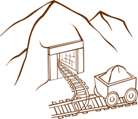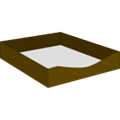Archive for the ‘Genealogy’ Category
The Reeds and a Natural Disaster
 American Ancestors, the family history center for the New England Historic Genealogical Society, puts out a genealogy related survey every week. Not long ago they asked whether an ancestor had been involved in a natural disaster.
American Ancestors, the family history center for the New England Historic Genealogical Society, puts out a genealogy related survey every week. Not long ago they asked whether an ancestor had been involved in a natural disaster.
I answered “no” because I was not aware of anyone who had been so affected. This week I learned that I may have such a connection after all.
I have come across an intriguing obituary that mentions my grandfather’s second cousin, Margueritte Reed (1894-1985), and the 1906 San Francisco earthquake.
Here is the backstory. Our common ancestor Thomas Reed (1783-1852) settled in Coles County, Illinois. I am descended from the second son, Caleb (1818-1903). Caleb’s older brother and Margueritte’s ancestor was Robertson Mitchell Reed (1808-1871).
Robertson was married twice and had two families. When the Reeds in Illinois attempted to put together a family history during the 1980’s, they could find little information on the second wife, Margaret Potts (1819-1871) and her children. No one seemed to know how many children there were or what became of them.
An article in The History of Coles County, Illinois (1876) claims Robertson and Margaret had 4 children: James W. (1857); Kate L. (1859); Joseph V. who married a Gould and went to Eugene, OR; and Anna Belle who married Schyler Glassco and went to Alabama. I decided to search again for the fate of these children, beginning with boys since they are easier to trace.
I found no record of James W. Reed born in 1857.
I did locate Joseph Van Reed, son of Margaret and Robertson Reed, who was born that same year. Could these sons, James and Joseph, be the same person? At least one Reed descendant thought Joseph was nicknamed James, but I have found no proof of this.
Leaving that question aside for now, I continued to look into the life of Joseph Reed.
Further investigation told me that Joseph left Coles County for New York where he perhaps married into the Gould family. A daughter Margueritte was born in New York City in 1894. Her obituary does not tell me her mother’s name.
By 1900, Joseph had removed to the west coast where he was working as a restaurant keeper in Portland and living in a boarding house. He had no wife or daughter with him, and the census listed him as a single man. Sometime later he returned to Coles County where he married Mamie C. Emerson in 1905.
Both his obituary and that of his daughter say the family (presumably Joseph, Mamie, and Margueritte) lived in San Francisco after the marriage. Margueritte’s article goes on to say the family left there after the 1906 quake to settle in Oregon.
The Joseph Reed family probably resided in San Francisco during the historic earthquake. I do not know how they were affected by it, but perhaps its aftermath was the reason they left the area and resettled in Oregon.
Did the Reeds in Illinois know of Joseph Van Reed’s time in San Francisco? The county history mentioned only that he went to Eugene, OR. By the 1980’s the Reed family members who remained in Illinois did not know even that much about their cousin Joseph.
My quest to learn the fate of Joseph V. Reed has given me an outline of his life and uncovered an interesting connection to a famous natural disaster.
Did Robertson Reed and Margaret Potts Have Sons?
 Over thirty-five years ago, a distant cousin wrote a genealogy of my Reed family. The Reeds of Ashmore by Michael Hayden traced the descendants of Thomas Reed (1783-1853), an original settler in Coles County, Illinois in 1829.
Over thirty-five years ago, a distant cousin wrote a genealogy of my Reed family. The Reeds of Ashmore by Michael Hayden traced the descendants of Thomas Reed (1783-1853), an original settler in Coles County, Illinois in 1829.
I descend from Thomas’ middle son Caleb, but he had two other sons as well, Robertson and William.
Robertson Mitchell Reed (1808-1871) was married twice. The Reeds of Ashmore includes extensive information on the family from his first marriage to Nancy M. McAlister but not so much on that of his second wife Margaret Ann Potts. The family genealogists at the time had difficulty learning whether there were 2, 3 or even 4 children. They had no idea of what became of them.
This week I decided to revisit this question. I began by searching for Robertson’s sons from the second marriage, reportedly James W. Reed (b. 1857) and Joseph M. or Joseph M. V. Reed (b. abt. 1860). These names came from census records and other county histories.
I needed to look at sources that have come available since then. I turned to a different county history, the Find A Grave site, Ancestry.com, and Newspapers.com.
A clue in the History of Coles County, Illinois (1876-1976) seems to have been overlooked by previous researchers. It reported two sons, James W., born 1857, and Joseph V. who married a Gould and went to Eugene, OR. This was only a starting point because other family information in this source is unreliable and needs independent verification.
I proceeded to uncover the following records:
- I located a grave for Joseph Van Reed (1857-1936) in Eugene, Oregon. The site linked to his wife Mamie Reed (1871-1907), buried in the same cemetery.
- Ancestry had an Oregon death certificate for this Joseph, and it states that he was born in Illinois. He was predeceased by his wife Mamie. The informant was Mrs. Clayton R. Jones.
- Newspapers.com showed an obituary for Joseph V. Reed. It did not include information on his family other than a surviving daughter, Mrs. Clayton R. Jones of Portland.
- Ancestry also had a 1905 marriage record for Joseph V. Reed and Mamie Emerson. They were married in Coles County, Illinois. The record states that Joseph V. Reed was the son of Robertson Reed and Margaret Potts.
These sources make it clear that Robertson and Margaret had a son, Joseph Van Reed, born in 1857 who married Mamie Emerson in Coles County in 1905. The couple then relocated to Eugene, OR where they remained for the rest of their lives.
So far I have found no record of another son named James W. Reed.
The earlier Reed researchers had thought Robertson Reed had two sons, James (1857) and Joseph (1860). Now I know that Joseph was the boy born in 1857, the purported birth year of James. No census record lists a James in the Robertson Reed household.
I believe Robertson Reed had just one son with Margaret Potts. He was Joseph Van Reed who may have been married more than once. His surviving daughter was too old to be the daughter of Mamie Emerson. After Joseph’s marriage to Mamie, the family went to Oregon to seek their fortune in gold. When she died a short time later, Joseph and his daughter Margueritte lived out their lives in that state.
Courthouse Research for Your Genealogy
 The genealogy societies in my area put on some terrific programs. The Highlands Ranch club came through with another one this week.
The genealogy societies in my area put on some terrific programs. The Highlands Ranch club came through with another one this week.
Dina Carson of Boulder, CO spoke on records one can find in courthouses and city halls.
I have visited many courthouses. My visits have been limited to stops at the courts and the Clerk and Recorder offices. I have collected vital records, divorces, guardianships, and land records during these visits.
Dina opened my eyes to many sources housed in these facilities that I had never thought about looking at.
She provided a page full of other city and courthouse offices that might hold records of interest. She suggested these:
- County commissioner
- Sheriff
- Assessor
- Agriculture
- Coroner
- Elections
- Parks and Open Space
- Public Health
- Treasurer
- Roads
- Surveyor
- Artwork
- Maps
I realized I could find additional information on some of my ancestors in these offices if I only looked.
For example, I wonder if my rural people would be mentioned in the agricultural records of their counties. I might be able to locate their livestock brands or see if they ever participated in a county fair. I know of one relative who did rodeo trick riding.
Another option for me would be to search sheriff’s records for some of my less law-abiding ancestors like those in Illinois who believed in homemade money.
This valuable program made me realize that I have endless research possibilities in local records.
Emptying the Reed Bin
 Each year I select one family line for my research. When I run across material for other lines, I toss it into a stackable bin to be addressed later.
Each year I select one family line for my research. When I run across material for other lines, I toss it into a stackable bin to be addressed later.
In the years since I last researched my Reed ancestors, their bin had started to overflow. I was eager to see what treasures were stored in there when I resumed the Reed research this year.
I began by sorting items by generation. Not only did I take papers from my own Reed bin, but I also pulled Reed research files compiled by a cousin. I found documents ranging for several generations back from my father:
- Earl Reed (1927-2017)
- Owen Herbert Reed (1896-1935)
- Samuel Harvey Reed (1845-1928)
- Joseph Caleb Reed (1818-1903)
- Thomas Reed (1783-1852)
- Caleb Reed (1756-abt. 1835)
- Thomas Reed (dates unknown)
Throughout January, I analyzed and filed the documents from my father’s and grandfather’s generations. I tossed duplicates from my cousin’s files.
As for the rest, I found several treasures including information about a cousin’s time at the Merchant Marine Academy and an uncle’s cattle brand used while he homesteaded in Wyoming.
My bin of papers included numerous research notes for my great-grandfather Samuel Harvey Reed. He lived in several states, and much more investigation into his activities could be done. But he is not my research subject this year, so I will move on from him for now.
This month I will turn to his father’s papers to see what I can file, what can be tossed, and what needs to wait until a later time.
Once I accomplish this, I can begin the research on my intended topic for this year, Thomas Reed (1783-1852). He was born in Fayette County, PA. The family relocated to Spencer County, KY where he raised his family. When land further north opened for settlement in the 1820’s, Thomas did not follow the rest of his family to Indiana. Instead, he moved with his wife and children to Coles County, Illinois.
That is where I will pick up the research on him and his life.
Volunteer!
 Genealogy societies operate thanks to the efforts of countless volunteers.
Genealogy societies operate thanks to the efforts of countless volunteers.
At this time of year, nominating committees convene to recruit people to fill vacant positions for the coming year. All are finding it increasingly difficult to find anyone willing to step into these jobs.
Among the local clubs I belong to, each one faces this problem:
- Colorado Genealogical Society. At a recent meeting, the chairman of their Nominating Committee gave an impassioned plea for volunteers. He told of three societies in Colorado that considered dissolving last year for lack of help. The club seeks a Vice President/Program Chairman and members for the 100th anniversary committee.
- Colorado Chapter of the Palatines to America. This German research group needs a President. Without a volunteer, it may fold.
- W.I.S.E. The group specializing in British Isles research (Wales, Ireland, Scotland, and England) threatened to close down until someone stepped forward into the Vice President role. Someone just came forward to allow the society to continue for the next term.
All these groups offer so much support to Colorado genealogists. Serving on the Boards offers the opportunity to do something meaningful for the genealogy community and to make new friends. Service keeps the clubs going for the benefit of everyone interested in family history.
Volunteer today!
Emptying a Cousin’s File Cabinet
 An old filing cabinet in my office has four drawers. They are crammed full of folders. They contain the lifetime genealogical research of my dad’s first cousin who began the work when she was 18 and died at ninety-three. Seventy-five years of loving, careful investigation and documentation. I face the job of reviewing it all and disposing of these papers in some way.
An old filing cabinet in my office has four drawers. They are crammed full of folders. They contain the lifetime genealogical research of my dad’s first cousin who began the work when she was 18 and died at ninety-three. Seventy-five years of loving, careful investigation and documentation. I face the job of reviewing it all and disposing of these papers in some way.
Our common ancestry is our Reed line, and much of the material in the cabinet pertains to that lineage. This cousin often sent me copies of her work, and I suspect I have duplicates of many of her documents in my own files.
Merging our work has seemed a monumental task, and I have put it off for a very long time. The cabinet continues to sit there, challenging me to do something with it.
As I have resolved to continue the Reed research this year, I decided to begin at last by pulling the Reed files from her cabinet for review.
The first folder included everything she had collected on her brother, Leslie H. Reed (1924-2008). It included so many treasures—his original birth and death certificates, newspaper clippings of accomplishments such a graduating from the U. S. Merchant Marine Academy, and his marriage record from Italy.
This week I verified that all this information has been entered into my own database. I made copies for my own records of any document I did not already have.
Now, the question arises of what to do with the originals. Should I return them to Leslie’s children who have no interest in genealogy? Should I add them to my archival box of Reed original documents?
I am still pondering this question.
In the meantime, the filing cabinet contains one fewer file folder.
A Different Sort of Genealogy Project
 New year, new project.
New year, new project.
Last year I finished the research on the last of my second great-grandparents. This year I will begin working on third great-grandparents. I have 16 sets to choose from.
Since my maiden name is Reed, I will begin with those ancestors. I hope to learn more about Thomas Reed (1783-1852) and Ann Kirkham (1782-1869) this year.
Since the last time I visited this bunch, I have collected a lot of Reed material. I tossed it all in a stackable bin to wait until I am ready to analyze it. The paper pile reached several inches high. In addition to all this, one of my Reed cousins left her research to me. I have Reed file folders and notebooks from her to review, too.
Much of her material duplicates what I already have. I can discard those pages.
The rest I am sorting into generational piles. Working backwards, I will enter the information into my database until I reach Thomas and Ann. Then I can begin with new research.
This year’s project will not only give me a chance to learn more about earlier Reeds, but it will also purge a lot of paper from my office. A happy new year, indeed.
The Genealogy Stacks Disappear
 The stacks of work-in-progress and other paperwork to be filed have disappeared from the table in my office. It did not happen by magic. I spent December, as I do every year, cleaning it all up.
The stacks of work-in-progress and other paperwork to be filed have disappeared from the table in my office. It did not happen by magic. I spent December, as I do every year, cleaning it all up.
It takes some time. I scrutinize each page, discard some, and file the rest in neat folders. I made new ones for all the Lawless and Ryan ancestors I discovered this year.
This tidying leaves clean work surfaces available for me to mess up again in 2023. I have 8 inches or so of documents for my Reed line waiting for attention. My father’s cousin left behind notebooks full of Reed information, too.
The first step in the Reed project will be to review these documents and add the information to my database. When I have accomplished this, I will begin some fresh research on this line, starting with my third great-grandparents, Thomas Reed (1783-1852) and Ann Kirkham (1782-1869).
They were original settlers in Coles County, Illinois in 1829. They will be my focus next year.
This will be my first attempt to do a research project on ancestors born in the 18th century. This couple grew up during the early Federal period. Records I am accustomed to searching did not exist at that time, and I will need to practice some new research techniques. It promises to be an interesting challenge.
The office is ready and waiting for me to begin in January.
Yule 2023
 As the winter solstice approaches on December 21, my husband/tech advisor and I are getting ready. We like to observe it every year.
As the winter solstice approaches on December 21, my husband/tech advisor and I are getting ready. We like to observe it every year.
We share Scandinavian heritage, and we enjoy imagining the old days when our ancestors must have celebrated the holiday in a big way. The pagans called it Yule. It was the go-to festival for the Vikings and the Germanic tribes.
They marked this shortest day of the year with animal sacrifices, toasts to the gods, Yule log fires, and lots of feasting. They decorated with evergreen wreaths, mistletoe, and holly.
At our house we recreate the holiday, but we tone it down a bit.
Our meal will be a delicious cod and bacon stew (a nod to my cod-fishing ancestors) washed down with mead. We will display a Yule log to bring good luck and keep away evil spirits. We may wear our Norwegian sweaters.
When the evening ends and we have had our fill, we can look forward to the return of the sun and the lengthening of days.
